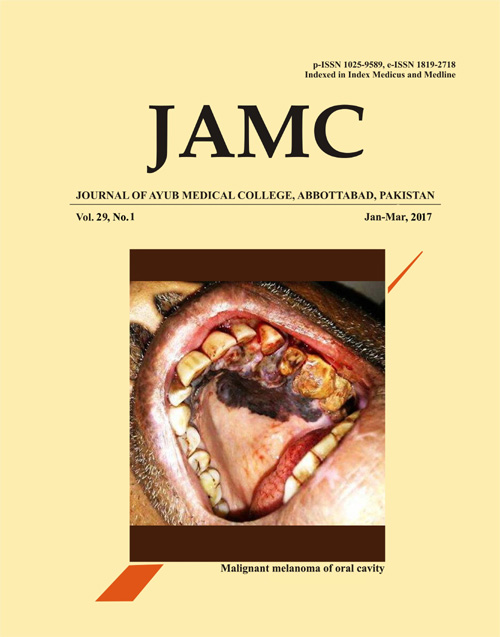CORNEAL COMPLICATIONS AND VISUAL IMPAIRMENT IN VERNAL KERATOCONJUNCTIVITIS PATIENTS
Abstract
Background: Vernal kerato-conjunctivitis (VKC) is an infrequent but serious form of allergic conjunctivitis common in warm and humid areas where air is rich in allergens. It affects both eyes asymmetrically. Although VKC is a self-limiting disease but visions affecting corneal complications influence the quality of life in school children. The aim of this study was to list the corneal complications due to this condition and to find out the extent of visual impairment among VKC patients. Methods: This cross-sectional study was conducted in the department of Ophthalmology, Benazir Bhutto Shaheed Hospital on 290 eyes of diagnosed cases of VKC. The diagnosis of VKC was made on the basis of history and examination. Visual acuity was recorded using Snellen’s notation and visual impairment was classified according to World Health Organization classification for visual disabilities. Results: The mean age of presentation was 10.83±6.13 years. There were 207 (71.4%) males and 83 (28.6%) females. Corneal scarring was observed in 59 (20.3%) eyes. Keratoconus was found to be in 17 (5.9%) eyes. Shield ulcer was detected in 09 (3.1%) eyes while 07 (2.4%) eyes had corneal neovascularization. Majority of the patients with visual loss had corneal scarring and the complication that led to severe visual loss in most of the eyes was Keratoconus. Conclusion: Vernal kerato-conjunctivitis in the presence of corneal complications is a sight threatening disease and can lead to severe visual impairment.Keywords: Vernal kerato-conjunctivitis; Corneal complications; Visual impairmentReferences
Kumar S. Vernal keratoconjunctivitis. Acta Ophthalmo 2009;87(2):133–47.
Bonini S, Bonini S, Lambiase A, Marchi S, Pasqueletti P, Zuccaro O, et al. Vernal keratoconjunctivitis revisited: a case series of 195 patients with long term followup. Ophthalmology 2000;107(6):1157–63.
Bremond-Gignac D, Donadieu J, Leonardi A, Poliquen P, Doan S, Chiambarretta F, et al. Prevalence of vernal keratoconjunctivitis: a rare disease? Br J Ophthalmol 2008;92(8):1097–102.
Leonardi A, Secchi AG. Vernal keratoconjunctivitis. Int Ophthalmol Clin 2003;43(1):41–58.
Bonini S, Coassin M, Aronni S, Lambiase A. Vernal keratoconjunctivitis. Eye (Lond) 2004;18(4):345–51.
Leonardi A, Busca F, Motterle L, Cavarzeran F, Fregona IA, Plebani M, et al. Case series of 406 vernal keratoconjunctivitis patients: a demographic and epidemiological study. Acta Ophthalmol Scand 2006;84(3):406–10.
Lambiase A, Minchiotti S, Leonardi A, Secchi AG, Rolando M, Calabria G, et al. Prospective, multicenter demographic and epidemiological study on vernal keratoconjunctivitis: a glimpse of ocular surface in Italian population. Ophthalmic Epidemiol 2009;16(1):38–41.
Tabarra KF. Ocular complications of vernal keratoconjunctivitis. Can J Ophthalmol 1999;34(2):88–92.
Ukponmwan CU. Vernal conjunctivitis in Nigerians: 109 consecutive cases. Trop Doct 2003;33(4):242–5.
Akinsola FB, Sonuga AT, Aribaba OT, Onakoya AO, Adefule-Ositelu AO. Vernal keratoconjunctivitis at Guinness Eye Centre, Luth (a five-year study). Nig Q J Hosp Med 2008;18(1):1–4.
Buckley RJ. Vernal keratoconjunctivitis. Int Ophthalmol Clin 1988;28(4):303–8.
Krachmer JH, Mannis MJ, Holland EJ. Cornea. 2nd ed. Philadelphia: Elsevier/Mosby; 2005.
La Rosa M, Lionetti E, Reibaldi M, Russo A, Longo A, Leonardi S, et al. Allergic conjunctivitis: a comprehensive review of literature. Ital J Pediatr 2013;39:18.
De Smedt S, Wildner G, Kestelyn P. Vernal keratoconjunctivitis: an update. Br J Ophthalmol 2013;97(1):9–14.
Cameron JA, Al-Rajhi AA, Badr IA. Corneal ectasia in vernal keratoconjunctivitis. Ophthalmology 1989;96(11):1615–23.
Leonardi A. Management of vernal keratoconjunctivitis. Ophthalmol Ther 2013;2(2):73–88.
Oray M, Toker E. Tear cytokine levels in vernal keratoconjunctivitis: the effect of topical 0.05% cyclosporine a therapy. Cornea 2013;32(8):1149–54.
Vichyanond P, Kosrirukvongs P. Use of cyclosporine A and tacrolimus in treatment of vernal keratoconjunctivitis. Curr Allergy Asthma Rep 2013;13(3):308–14.
Sacchetti M, Baiardini I, Lambiase A, Aronni S, Fassio O, Gramiccioni C, et al. Development and testing of the quality of life in children with vernal keratoconjunctivitis questionnaire. Am J Ophthalmol 2007;144(4):557–63.
Shafiq I, Shaikh ZA. Clinical presentation of vernal keratoconjunctivitis (VKC): A Hospital based study. J Liaquat Uni Med Health Sci 2009;8:50–4.
Saboo US, Jain M, Reddy JC, Sangwan VS. Demographic and Clinical Profile of Vernal Keratoconjuctivitis at a tertiary eye care centre in India. Indian J Ophthalmol 2013;61(9):486–9.
Published
Issue
Section
License
Journal of Ayub Medical College, Abbottabad is an OPEN ACCESS JOURNAL which means that all content is FREELY available without charge to all users whether registered with the journal or not. The work published by J Ayub Med Coll Abbottabad is licensed and distributed under the creative commons License CC BY ND Attribution-NoDerivs. Material printed in this journal is OPEN to access, and are FREE for use in academic and research work with proper citation. J Ayub Med Coll Abbottabad accepts only original material for publication with the understanding that except for abstracts, no part of the data has been published or will be submitted for publication elsewhere before appearing in J Ayub Med Coll Abbottabad. The Editorial Board of J Ayub Med Coll Abbottabad makes every effort to ensure the accuracy and authenticity of material printed in J Ayub Med Coll Abbottabad. However, conclusions and statements expressed are views of the authors and do not reflect the opinion/policy of J Ayub Med Coll Abbottabad or the Editorial Board.
USERS are allowed to read, download, copy, distribute, print, search, or link to the full texts of the articles, or use them for any other lawful purpose, without asking prior permission from the publisher or the author. This is in accordance with the BOAI definition of open access.
AUTHORS retain the rights of free downloading/unlimited e-print of full text and sharing/disseminating the article without any restriction, by any means including twitter, scholarly collaboration networks such as ResearchGate, Academia.eu, and social media sites such as Twitter, LinkedIn, Google Scholar and any other professional or academic networking site.









